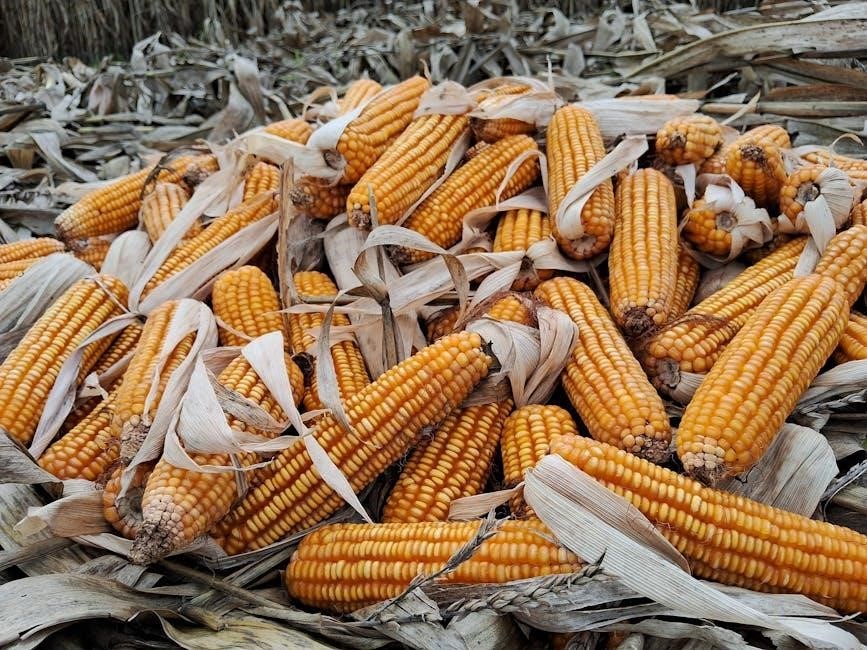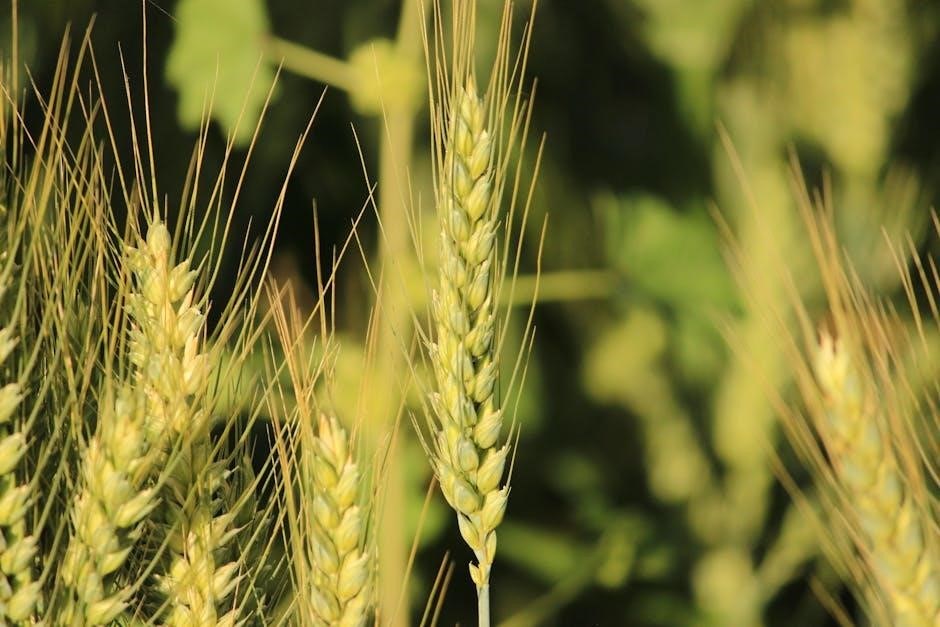The limiting reactant and percent yield are fundamental concepts in stoichiometry‚ crucial for determining reaction outcomes and efficiency in experimental chemistry and real-world applications.
Definition of Limiting Reactant
The limiting reactant‚ also known as the limiting reagent‚ is the reactant that is consumed first in a chemical reaction‚ determining the maximum amount of product that can be formed. It is the reactant that is present in the smallest stoichiometric amount relative to its molar ratio in the balanced chemical equation. Identifying the limiting reactant is crucial in chemistry‚ as it helps predict the theoretical yield of a reaction and optimize experimental conditions to minimize waste. The concept applies broadly in laboratory experiments and industrial processes‚ ensuring efficient use of resources. Understanding the limiting reactant is foundational for stoichiometric calculations and reaction analysis.
Definition of Percent Yield
Percent yield is a measure of the efficiency of a chemical reaction‚ comparing the actual yield of a product to the theoretical yield predicted by stoichiometry. It is calculated using the formula:
(Actual Yield / Theoretical Yield) × 100
A percent yield less than 100% indicates not all reactants were converted to products‚ often due to side reactions or incomplete reactions. A yield greater than 100% suggests an error in measurement or calculation. Understanding percent yield is essential for optimizing reactions and assessing experimental accuracy in chemistry and industry.
Key Concepts in Limiting Reactant and Percent Yield Calculations
Stoichiometry and balanced equations guide calculations. Reactant ratios determine limiting reactants‚ while theoretical yield comparisons reveal percent yield‚ ensuring accurate predictions and evaluations of chemical reactions and efficiency.
Understanding Stoichiometry and Molar Ratios
Stoichiometry is the foundation of chemical calculations‚ focusing on the quantitative relationships between reactants and products in a balanced chemical equation. Molar ratios‚ derived from the coefficients in the equation‚ determine how reactants interact. For example‚ in the reaction P₄O₁₀ + 6H₂O → 4H₃PO₄‚ the molar ratio of P₄O₁₀ to H₂O is 1:6. Calculating moles of reactants and comparing them to these ratios identifies the limiting reactant. Accurate molar masses and balanced equations are essential for precise calculations. This concept is critical for predicting theoretical yields and optimizing reactions in experimental and industrial settings.
Importance of Balanced Chemical Equations
Balanced chemical equations are essential for accurate stoichiometric calculations‚ as they provide the mole-to-mole relationships between reactants and products. Without a balanced equation‚ determining the limiting reactant or calculating percent yield becomes impossible. Each side of the equation must have equal numbers of atoms for each element‚ ensuring precise reactant ratios. This balance allows chemists to predict theoretical yields and compare them with actual experimental results. Accurate balanced equations are critical for identifying limiting reactants‚ calculating excess quantities‚ and assessing reaction efficiency‚ making them a cornerstone of chemical problem-solving and experimental design.

Steps to Determine the Limiting Reactant
Calculate moles of each reactant using molar masses. Compare reactant ratios to stoichiometric ratios. Identify which reactant is consumed first‚ determining the limiting reactant.
Calculating Moles of Reactants
To determine the moles of reactants‚ use the formula: moles = mass / molar mass. Find the molar mass from the periodic table by summing atomic masses of elements in the compound. For example‚ for P4O10: (4×31) + (10×16) = 284 g/mol. Convert the given mass of each reactant to moles using their respective molar masses. Accurate calculations are crucial for identifying the limiting reactant and calculating percent yield. Ensure precision by double-checking molar masses and computations. This step lays the foundation for subsequent stoichiometric analysis.
Comparing Reactant Ratios to Stoichiometric Ratios
Comparing reactant ratios to stoichiometric ratios is essential to identify the limiting reactant. Calculate the mole ratio of reactants provided and divide by their coefficients in the balanced equation. The reactant with the smallest ratio relative to its stoichiometric requirement is the limiting reactant. For example‚ if a reaction requires a 2:1 ratio of A to B and only 1.5:1 is available‚ A is limiting. This step ensures accurate determination of the limiting reactant‚ crucial for predicting theoretical yields and reaction efficiency. Always use balanced equations to maintain precise calculations.

Calculating Percent Yield
Percent yield is calculated by comparing actual yield to theoretical yield‚ using the formula: (Actual Yield / Theoretical Yield) × 100. This measures reaction efficiency and identifies losses.
Theoretical Yield vs. Actual Yield
Theoretical yield is the maximum amount of product that can be formed based on the limiting reactant and balanced chemical equation‚ assuming no losses. Actual yield is the amount of product actually obtained in an experiment. Theoretical yield is calculated using stoichiometric ratios‚ while actual yield is measured experimentally. Factors like incomplete reactions‚ side reactions‚ and impurities often reduce actual yield below theoretical values. Comparing these two helps determine reaction efficiency. Percent yield is calculated by dividing actual yield by theoretical yield and multiplying by 100. Understanding this distinction is critical for optimizing chemical processes and troubleshooting experimental results effectively.
Percent Yield Formula and Application
The percent yield formula calculates the efficiency of a chemical reaction by comparing actual yield to theoretical yield: Percent Yield = (Actual Yield / Theoretical Yield) × 100.
Actual yield is the amount of product obtained experimentally‚ while theoretical yield is the maximum amount predicted by stoichiometry.
This concept helps identify reaction inefficiencies and is widely used in laboratory and industrial settings to evaluate performance.
For example‚ if a reaction produces 0.71 g of Cl₂O but theoretically yields 0.86 g‚ the percent yield is approximately 82.56%.
Practicing with worksheets ensures mastery of these calculations for real-world chemistry applications.

Common Problems and Solutions
Handling excess reactants and incomplete reactions are common challenges. Calculating exact amounts and understanding reaction completion is key to accurate results and minimizing errors in experiments.
Handling Excess Reactants
Excess reactants remain after a reaction is complete‚ as they are not fully consumed. To identify them‚ compare the available moles of each reactant to the stoichiometric ratios in the balanced equation. The reactant with more moles than required is in excess. For example‚ in the reaction 2A + 3B → 5C‚ starting with 10 moles of A and 12 moles of B‚ B is limiting because it requires 15 moles of B for 10 moles of A. After the reaction‚ 2 moles of A remain as excess. Properly handling excess reactants ensures accurate limiting reactant identification and theoretical yield calculations‚ crucial for precise stoichiometric analyses and percent yield determinations.
Dealing with Incomplete Reactions
Incomplete reactions occur when reactants do not fully convert to products‚ often due to equilibrium. This affects both limiting reactant determination and percent yield calculations. The limiting reactant may still be present‚ complicating its identification. Percent yield is lower than theoretical maximum because not all reactants are consumed. Using ICE tables helps track equilibrium concentrations‚ essential for accurate calculations. Understanding equilibrium principles and adjusting for incomplete conversion is crucial for solving such problems effectively.
Example Problems with Solutions
Example: If 3 moles of P₄O₁₀ and 9 moles of H₂O react‚ P₄O₁₀ is the limiting reactant. The theoretical yield of H₃PO₄ is 12 moles‚ with a 75% yield resulting in 9 moles produced.
Sample Limiting Reactant Calculation
Consider the reaction: P₄O₁₀ + 6H₂O → 4H₃PO₄. Suppose 3 moles of P₄O₁₀ and 9 moles of H₂O are available. The stoichiometric ratio is 1:6. Divide each reactant’s moles by its coefficient: 3/1 = 3 and 9/6 = 1.5. Since 1.5 < 3‚ H₂O is the limiting reactant. Calculate the theoretical yield using the limiting reactant: 1.5 moles of H₃PO₄. If only 1.2 moles are obtained‚ the percent yield is (1.2/1.5) × 100 = 80%. This demonstrates how to apply limiting reactant and percent yield calculations in practical problems.
Sample Percent Yield Calculation
For a reaction where 3 moles of P₄O₁₀ react with 9 moles of H₂O‚ the theoretical yield of H₃PO₄ is calculated. If only 8.5 moles are obtained‚ the percent yield is determined. Using the formula:
Percent Yield = (Actual Yield / Theoretical Yield) × 100‚ the calculation becomes:
(8.5 / 9) × 100 = 94.4%. This demonstrates how to apply the percent yield formula to assess reaction efficiency‚ ensuring accurate analysis of experimental outcomes compared to theoretical predictions.

Best Practices for Solving Worksheets
Organize data systematically‚ calculate stepwise‚ and verify each step. Compare results with theoretical values to ensure accuracy and apply formulas correctly‚ ensuring unit consistency always.
Organizing Data and Calculations
Organizing data and calculations is essential for accuracy and clarity in solving limiting reactant and percent yield problems. Start by creating a table or list to record given masses‚ molar masses‚ and moles of each reactant. Clearly label calculated values‚ such as theoretical yields and actual yields‚ to avoid confusion. Separate theoretical calculations from experimental data to ensure transparency. Highlight the limiting reactant once identified to focus subsequent steps. Double-check all mathematical operations‚ and verify units to maintain consistency. Proper organization helps in identifying errors early and streamlining the problem-solving process.
Verifying Results for Accuracy
Verifying results ensures the accuracy of calculations in limiting reactant and percent yield problems. Always double-check mole calculations‚ stoichiometric ratios‚ and theoretical yields. Compare actual yields with theoretical values to assess efficiency. Ensure all units are consistent and significant figures are appropriately considered. Recalculating steps and reviewing formulas can help identify errors. Cross-referencing with balanced chemical equations and reaction stoichiometry is essential. Attention to detail in verifying results enhances the reliability of conclusions‚ making it a critical step in solving worksheet problems effectively and understanding reaction dynamics accurately.



